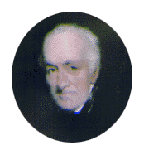Elizabeth
WadsworthLily of the Valley (continued)

James Wadsworth"No
daughter of mine will ever marry
a damned Englishman."
James
Wadsworth
Upon his return east, Murray again tried to claim
Elizabeth's hand, but her father was adamant. His wife and other daughters had
died, and James needed Elizabeth to care for him and the household. His ancient
prejudice against the British, inflamed by the memory of the 1812 war, boiled
over and he vowed that, "no daughter of mine will ever marry a damned Englishman."
Lord Murray left with a heavy heart. He returned to England where he was
appointed head of Queen Victoria's household. While Murray's career advanced,
Elizabeth kept busy on her side of the Atlantic. With her father in declining
health and her two brothers often away, it fell to Elizabeth to manage the household
and the family's growing land empire. She even helped care for her brother's six
children.
Life was busy, but Elizabeth continued to attract suitors.
Despite profound political differences, her father permitted "Prince"
John Van Buren to visit his daughter. John was the dashing son of the former Democratic
president, James Wadsworth was a staunch Whig. Charles Sumner, who later became
Lincoln's Secretary of War, was among those who visited the Geneseo beauty. According
to rumor, she refused marriage proposals from at least two hopefuls.
One particularly ardent suitor, George Sydney Fisher, wangled an invitation to
Geneseo in 1848. Fisher's diary tells much about Elizabeth, describing how she
sat for hours before the Homestead fireplace reading Virgil and Horace. He recounted
with admiration how she bested the local politicians and saved the village square
in 1846.
Fisher tried to convince Elizabeth that "her life was without
its best interest and purpose, wanting which no true female nature finds happiness."
Translated from Victorian prose, Fisher was opining that it was time Elizabeth
married and had a family of her own.
Fisher's courtship failed, but
he did unlock the secret of Elizabeth's behavior. "It implies some powerful
secret cause that such a woman of warm affection can lead such a life." How
right he was!
Her father had gotten his way in life, even forbidding
Elizabeth and Charles from corresponding, yet, after his 1844 death, love letters
again flowed across the Atlantic. Murray wrote from his diplomatic post in Naples
and then from Cairo where he was appointed Counsel General. Each letter was more
persistent.
Finally friends invited Elizabeth to sail with them to tour
the British Isles. The party was traveling by rail from Glasgow in July 1850,
when it stopped at the small Scottish village of Carlisle.
Elizabeth
noticed a tall, fashionable aristocrat preparing to board the train. He was assisted
by a dark complected attendant, who wore a fez. Elizabeth mused that perhaps the
gentleman had recently returned from the Orient. Could it be her one true love?
To her shock, it was! Lord Charles had returned from Egypt to rendezvous
with his beloved. Long years of loneliness fell away as they embraced.
A Westminster Abbey wedding was quickly scheduled, allowing just enough time for
Elizabeth's brother, James S. Wadsworth, to arrive and give the bride away.
After crossing a shining Mediterranean Sea to Cairo, their last honeymoon
night was spent on the Mena House balcony with European royalty. Charles and Elizabeth
sat holding hands and gazing into the moonlight late into the evening.
3
Back | Next
According
to WebCounter you are the  person to answer the Clarion Call
person to answer the Clarion Call
©2008 Clarion Publications, Inc. All
Rights Reserved.
This site designed by Clarion Communications. | |

